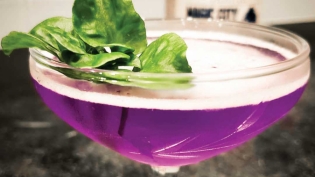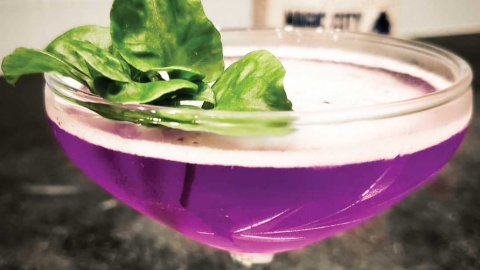Backyard Alchemy: Cocktails Whipped Up with Whatever’s Growing
It was Erik Lowman’s Instagram feed that caught our attention – beautifully styled cocktails, fabulous glassware and garnishes: black sapote fruits, Bahamian bird peppers, red dragonfruit, tropical flowers, props that scream South Florida. To make his cocktails, Lowman draws upon childhood experiences here and on a Midwestern family farm, working with two of Miami’s best-known chefs, and his own inventiveness in using backyard flora.
Lowman, a physician who specializes in treating infectious diseases, grew up splitting his time between Iowa, on his grandparents’ farm and in his dad’s restaurant, and Key Biscayne with his mother’s Cuban family. “I think I was nine years old the first time I tasted guanabana ice cream my abuela got from a place on Calle Ocho,” he says.
Genuine Inspiration
During college, he worked at a variety of restaurants, majored in literature in college, then returned to Miami, where he started working for Michael Schwartz and Hedy Goldsmith at Nemo on South Beach. “They were both amazing, as you’d expect, but in very different ways,” he says. “Michael seemed like a Jedi master. He’d walk into the kitchen and seem to create something fully formed, like Athena springing from the head of Zeus. Hedy had a Thomas Edison tinkering persistence.”
After a few years, Lowman left the restaurant industry to go to medical school. After completing his fellowship, he started fooling around with fermenting, tinkering with baking bread, making cheese and brewing ginger beer. “It seemed like a good balance to attack yeasts and bacteria at work, but be cordial with them when off the clock.”
Today, Lowman and his family live in Miami Shores, where his lush backyard garden is home to raised beds for herbs and vegetables, fruit trees and a dedicated bed for flowers, created with the help of Little River Cooperative. Like any garden, it’s a work in progress. “I’m always thinking, ‘Is this native? Does it feed pollinators? Is it prone to diseases? Is it delicious? Does it have other uses? Is it beautiful?’ Not always in that order – frankly, delicious will sometimes overrule the others – but I’m always concerned about the other factors.”
Summer of Tiki
Last summer, he was feeling nostalgic about summers in Iowa. “Your neighbor would stop by with a grocery bag full of too much of something from their garden, and you would get to figure out how you could use it,” he recalls. “Most summers were full of corn chowder, corn bread and an endless supply of corn on the cob. You used it because you had it. This is such a different approach than thinking about what you want to make and going to the store to buy the ingredients.”
So he decided to make it a #SummerOfTiki, reviving Prohibition-style cocktails using what he grew and decorating them with backyard flowers. His Bahamian bird pepper plant had taken off, so he made hot sauce to bottle and give away. “Every drink I made for about a five-week period used the Bahamian bird peppers that I made the hot sauce out of,” he says. “I used ginger/pepper simple syrup as a base, I blended them with pineapple and mixed it with mezcal.”
Another tropical fruit he used was black sapote, whose creamy, almost-black pulp looks like chocolate but tastes, well, sweet. Lowman blended frozen black sapote, Hell’s Bay Rum, homemade bitter liqueur and aloe to create a drink that looked more like a 7-11 cola slushie. He also thought black sapote would make a good hot sauce.
“I used chef Michael Schwartz’ recipe as a base, subbing the sapote and a banana for the veggies, Bahamian peppers for the habaneros, rice vinegar for the champagne vinegar, and ginger simple syrup for the agave. I added a bit of turmeric, allspice, cardamom and smoked salt to the spices and warmed them in a saute pan before adding them to the mix. I eliminated the added water, and cut the vinegar in half because the sapote has a lot more water than carrots and bell peppers.”
Mamey sapote turns up as a syrup in some of his cocktails. “Mamey is thick – both viscous and robust. Mamey’s rich, complex flavor does so much better in contrast and in compliment. If you’re feeling really ornery, just to prove how robust mamey’s flavor is, rim the glass with smoked salt.”
What’s next for summer? “I think it’s going to depend on what’s in abundance, but I’m thinking about making some punches by fermenting fruits in a series, using a technique similar to a sour mash,” he says. “Coming up with some combinations of Miami fruits could be a fun way to spend a summer.”






